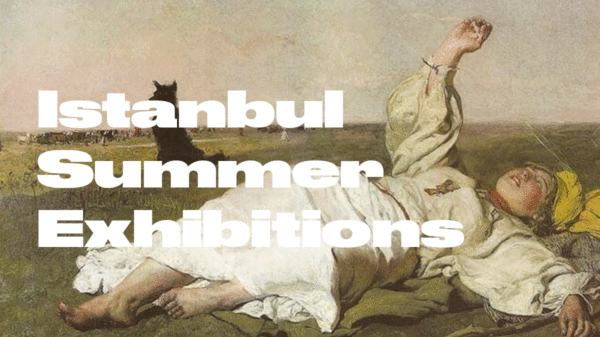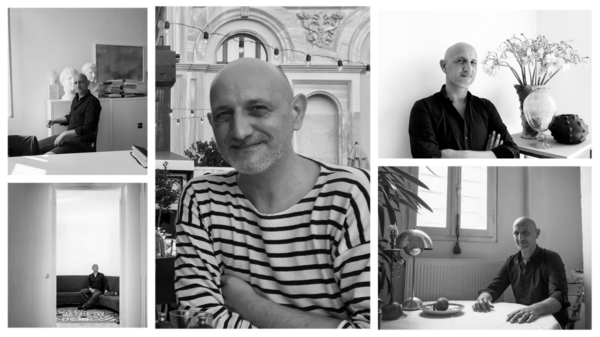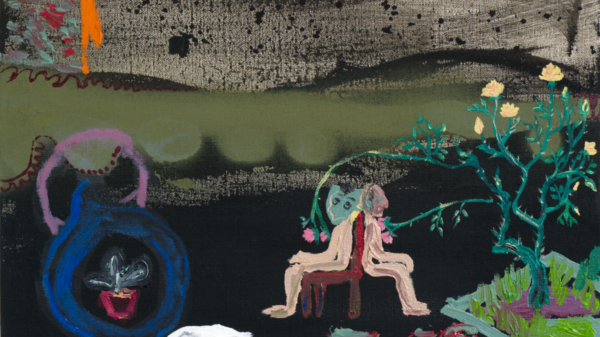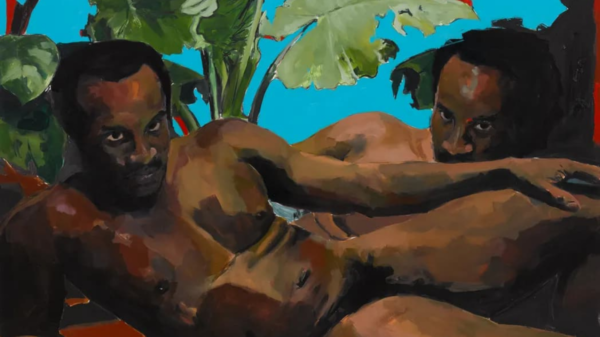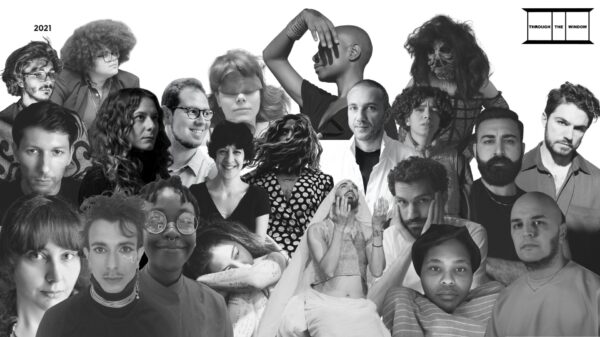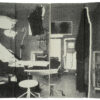Victoria Miro x OUT Collective
An ode to light and being-in-relation, Victoria Miro x OUT Collective on Vortic presents figurative works curated with togetherness in mind. Selected by Kudzanai-Violet Hwami, Doron Langberg, and Russell Tovey, duality abounds as figurative couples and pairs of paintings speak to each other and implicate the spectator in their conversation. These are subjects that come to be in relation to one another, and that invite us to feel the glow or the discomfort of that touch. The works in this exhibition engage the figurative tradition by queer and experimental means.
Kudzanai-Violet Hwami, selector and artist, presents two paintings in dialogue: Jonga 1, 2021 and Jonga 2, 2021. The works confront the spectator with the repeated gaze of a nude Black man. Chin tilted towards his chest, eyes direct, we feel the weight of the stare, implicating the act of looking. Despite the figure’s apparent masculinity, their genitals are obscured in shadow or omitted. The artist refuses to centre the phallus in the representation of Black masculine eroticism. This refusal speaks to the poet Essex Hemphill’s essay “Does Your Momma Know About Me?” in which he criticises Robert Mapplethorpe’s The Black Book and its representations of black masculinity in fetishized, fragmented body parts. In Jonga 1, an ecstatic vermillion background and the broad leaves of a banana tree fill the space beyond the figure, insistently erotic in their vitality. As source material the artist uses family photographs, online archival images, and vintage pornographic photographs, and I wonder how many times this performance has been reiterated. In Jonga 2, the figure is repeated, layered in a mirror image of Jonga 1, and its inverse. Cyan illuminates the scene inverting the colour of Jonga 1, and creating a sense of digital manipulation: figures cut, flipped and repeated, colours inverted, in facsimiles of seduction, sliced from time and place.
From one inverted seduction to the next, Ana Benaroya’s blazing works, Constant Craving Has Always Been, 2021 and A Great Magnet Pulls All Souls Towards Truth, 2021 envelop me with their heat. The works invert each other’s light and colour in blistering hues of yellow into red. The glowing duo presses their hot lumps against the surface of the painting. Deliriousness pushes towards us, the blissed-out smiles, the turgid, disarticulated bodies, the cartoonish puffs of smoke, the coiffed Dolly Parton hair. We’re close to hell but we’re having a good time. Viewing them in the dim light, my amusement lit up by the laptop screen, I feel myself mirroring their expressions.
Intimacy and queer family brim in the work of Didier Williams, Kyle Coniglio, Doron Lanberg and Sola Olulode. In William’s, Red Bush, 2021, on the threshold of domestic space, two figures shimmer in white noise. The fragments that make up the bodies are carved into the surface, drawing us into three-dimensionality. The figure to the right appears to clutch their head, in anguish and ecstasy, overwhelmed by their own (dis)articulation. By making visible the ways our particles are constantly trembling, this work mocks the illusion of its own material stasis. As the eye lands on a spot, another distracts us, so that the bodies quiver like a shoal of fish.

Held in the dense haze of Coniglio’s Boardwalk Buddy, 2021, the central figure gazes towards us with a look of sheer contentment at our nearness. The lolling fronds that rise on either side of the boardwalk reach tenderly toward them as might a loved one. In Night Walk, I feel myself performing the warm gaze of a partner catching sight of their person unawares.
Doron Langberg’s intimate portraits contextualise each other in queer kinship, as friend and family are presented in tandem. Willy, 2021 presents a portrait bruised and ablaze, the artist sharing space and a cigarette with a loved one at the embers of a day. The sparing brushwork tells the fallibility of portraiture in its attempt to capture wholeness: the white space, the lips of paint that overlap, dissonant shades coalescing in the trace of movement. Gal, 2021, is a portrait of their nephew who blushes and looks away, the warm yellows casting them in the light of someone deeply loved. We are brought close by the artist in these smaller scale works, cropped tightly on the subject.
Sola Olulode’s Lunch Date blazes with Black joy. Two Black femmes face one another across a table in perfect equilibrium. They are the centre of their own sphere of energy. The two melt, their surroundings piercing their soft figures with light as they embrace in stillness, not grasping but certain. In Sunlight, two figures stand awkwardly side by side, fingers brushing, their ghosts kissing beneath them, the glow of yellow sun dizzying their form. Touch both anticipated and realised.

Disruptive forces are at play here too. Nash Glynn’s two paintings remind us that it’s their world, we’re just living in it. In Self Portrait with Robot, 2018, against a cascade of fake blood, a robot takes a femme from behind while they look toward the spectator. Forcing us to consider this strange scene, the artist bares their power to do so. Glynn’s Untitled (Landscape), 2021 looks out from across the room, looping us back to Hwami’s considerations of the nude, gender, and the violence of the white, cis-normative gaze. A trans-femme person, lays across velvety green meadows beneath a tall blue sky. Playing with associations between binary sex-gender, the ‘female’ nude, landscape, and the natural world, the artist disrupts the naturalisation of such associations by centring trans-femininity.
In a stark turn from warmth, Shadi Al Attalah’s your highest tide, 2021, spits out a sprawling black figure, its limbs tearing from its centre, clawing desperately towards the light that fragments the scene. The figure appears to be in the throws of disarticulation. Its form abandoned by its edges, spewing out its liquids. In the background the outline of a doorway and a squat figure in red, on the threshold of return or abandonment, burns like the guilty cause of this destruction. In to propagate his vision, 2021, the central figure stands erect with determination, oil slicked, and contaminating, their form indiscrete and clawing at its own painted surface, troubled by the form. This collection of work bleeds vitality and pushes against the limitations of representation with bliss, wit and frustration.
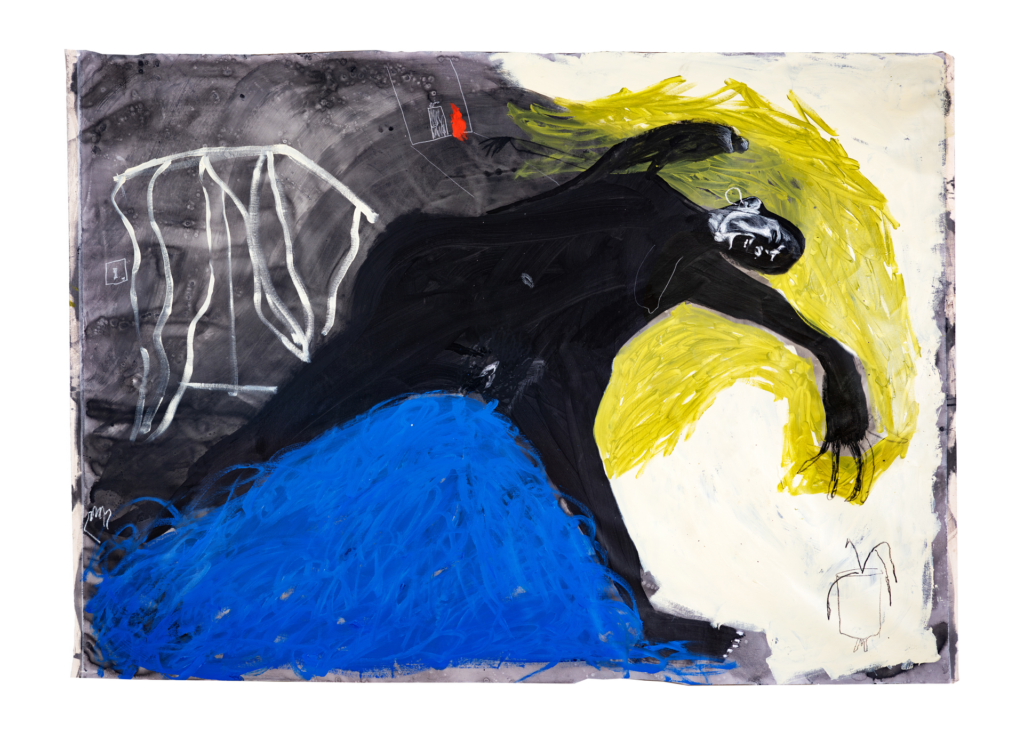
Zilberman Gallery x OUT Collective
In Zilberman Gallery’s virtual space Erinç Seymen presents two quietly moving works, The Worrying Mansion, 2017, and Holy Process, 2017, two HD video loops. His work examines the spiritual emptiness of Capitalism and its apparatuses. In The Worrying Mansion, a grand house towers above the viewer in grayscale, its windows anthropomorphically spewing its contents. These contents are indiscernible and ooze relentlessly from the building. Sand from an hourglass, the detritus of life, a horde of vermin. The mound of waste never grows, and the flow never ceases and yet we are trapped in the movement. Behind the building the sky is a clotted smoke screen, obscuring any sense of time or place, with no evidence of life to be found. Dislocated from specificity, the spectator is doomed to this ceaseless loop. The scene mimics the psychic space of trauma: the threat which never realises itself. The house nullifies its function to contain, to protect.
The artist posits that the work refers to the pathological anxieties that result from owning and preserving wealth, an expression of the anxious concerns, ‘what if I lose?’ or ‘what if I get looted?’ Indeed the impetus of Capitalism is accumulation, so this house could be understood as the anxious mental loop of the Capitalist. More than this though, the mansion, the symbolic epitome of a hoarding of wealth, vomiting its contents speaks to guilt, a desire for the abject, for the casting out of all which maintains one’s status. Repulsed perhaps by its own existence.
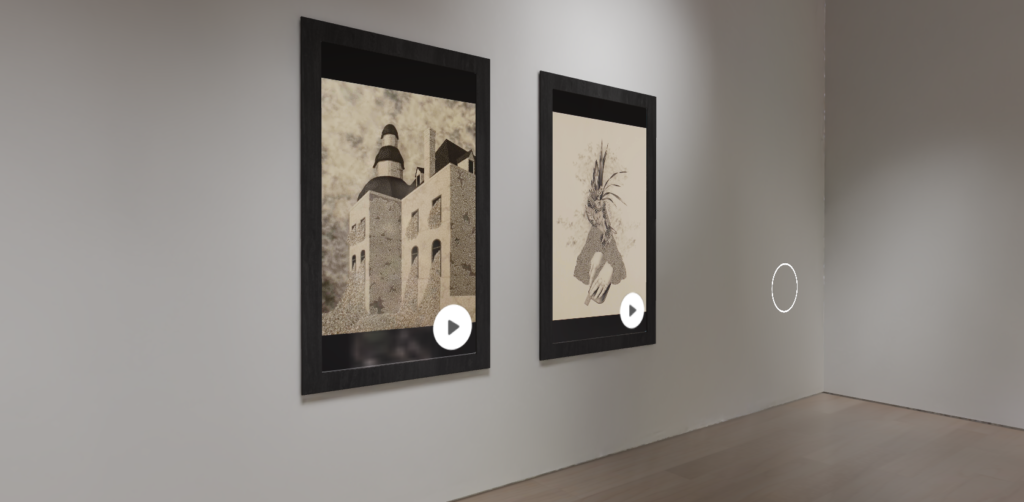
In Holy Process feminine hands emerge from a heap of grey matter adorned with tropical flowers. The hands repeat their movement in a loop, cutting a surface with a scalpel and ruler. The indeterminate mass shivers almost imperceptibly, an illusion of growth. Behind this, smoke hovers, never fully retreating. Hands make me think of labour, the most common tools by which we work. The hands are amputated from self and memory, of why they labour. The work is ceaseless and without progress. Sisyphean, the hands press on. The artist performs the empty religiosity of labour, the flowers a gift of thanks, an offering to the mound. I think about the invisible labour and abuse of women and migrant workers that fills mansions like these[1]. And I wonder if those for whom their labour is in service feel this anxiety to preserve, that they might be looted. I think that they sleep well anyway. Spectres of wealth and labour, the images haunt each other. The house making a fool of the hands work, the hands whose work will never satisfy the house.
Central Galeria x OUT Collective
Ros4 Luz’s moving image work, Thanksgiving, 2020, covers the wall of the virtual gallery space. In black and white, the artist strides down Northampton’s Cultural Quarter in a white toile gown, white sunglasses, platform heels. A runaway bride. The image stutters and repeats, accompanied by synthetic drums and a hollow refrain announces the artist’s verse. The opening line cuts the repetition with, ‘White bitch in the street is looking at me, so jealous of this Brazilian Travesti’ which sets the tone for the lyrics that follow. The term ‘Travesti’ is an expansive Latin American term which can refer to trans-femme’s who were assigned male at birth, but do not necessarily consider themselves women or seek gender affirming surgeries.

The artist performs loudly in public space, rising from a mirrored surface in the middle of a crowded high street, crawling and writhing in the street to the bemusement and curiosity of onlookers. White women watch as she commands the space, refusing assimilation. This refusal is at once comedic and powerful. Now redelivered in this virtual gallery space, the crowd is disarticulated from assimilation, their performance of normativity, their reactions, made part of the spectacle. This public performance ruptures the veneer of normativity, and could be described as “monstering” – a strategy by Trans and Travesti people in Latin America to resist the assimilation that accompanies legitimisation by the state, a response to the concern that legal and social recognition does not in itself protect the lives and ways of being of gender non-conforming people.[2] The artist mocks the shock of the milieu in their persistence, but also hits back at the violence faced by their community, their rhymes decrying sugar daddies and politicians who try to kill them. The artist uses absurdity as a promise of their commitment to disruption, warning that if their ‘black sisters’ are harmed, she will return the violence. What does it mean for a black trans woman from Brasil to demand public space, on British streets, and now in the virtual space of this exhibition? The work asks us, what are you doing to disrupt the violence of assimilation and erasure perpetuated by the state? It punctures the banality of white cis-normativity reminding us of our complicity, our bodily autonomy, our capacity for disruption.

Thanksgiving was edited from an earlier work, Silent Path, 2015 created during a residency in England, in which the artist was silent for 15 days, wearing this wedding dress, and concluding the action with a walk through the streets. This performance work is documented in black and white photographs, Untitled – The Silent Path, 2015, which line a wall across from the film. The artist stands, dressed in white, beside emblems of Britishness: red telephone boxes, an obelisk adorned with flags, a high street, a bronze statue – monuments to forgetting. Bodies like theirs have always existed in spite of the erasure that such monuments narrate. In one photograph, Trans Women Eliminated or Brazil is the country that kills the most transvestites and transsexuals in the world!, 2015, the artist lays as though sleeping, in a skip, filled with construction waste, a reference perhaps to the deaths made invisible by the apparatuses of capitalism and the state.
Glowing against this marking of presence is a different mode of protest. Deyse Ex-Machina, 2021, a self-portrait of the artist dressed in white, ready for the club, reclines against a foil backdrop bathed in pink light. The DIY fantasy of noughties R&B pop princesses. The ease and make-shift glamour of the image speaks to the thrifty creativity of the queer club scene. Its removal from spatial and temporal specificity creates a space for speculative contexts against which the artist can narrate their own story.
[1]https://www.theguardian.com/news/audio/2021/jan/27/behind-closed-doors-filipina-workers-trapped-by-the-pandemic

